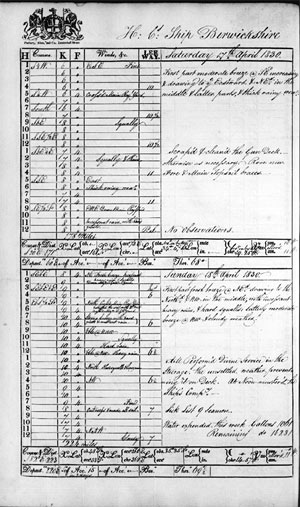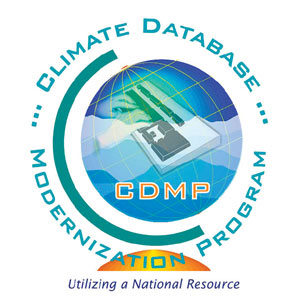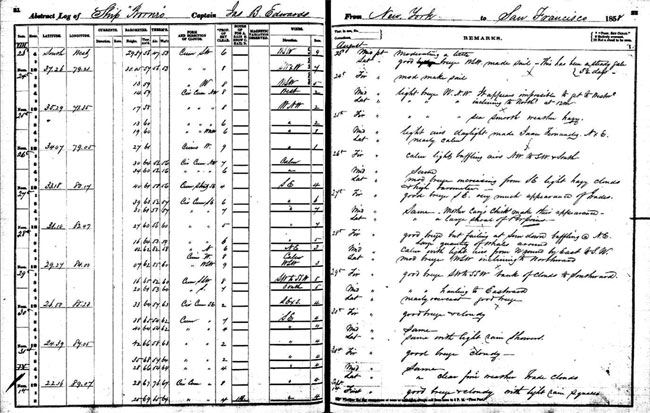NOAA’s Climate Database Modernization Program (CDMP):
Sailing to the Future with Historical Marine Observations
Eric Freeman, T. F. Ross, National Climatic Data Center

Logbook image from the East India Company Ship ëBerwickshireí. CDMP is currently involved in an international effort to digitize East India Company logbooks held at the British Library.(Click for larger image)
The Climate Database Modernization Program (CDMP) is a program of the National Oceanic and Atmospheric Administration (NOAA) designed to preserve historic climate and environmental data and make them available online. Under the auspices of NOAA’s National Climatic Data Center (NCDC), the world’s largest active environmental data archive, CDMP works with national and international agencies to preserve historic records, some dating back to the mid-eighteenth century. CDMP preserves various types of data including: surface marine/terrestrial weather observations, upper air observations, biological data, historic photographs, plus much more. Although CDMP preserves a wide variety of environmental data, there is also a long term commitment to digitize marine observations and make them available to national and international databases.
Working with the US Voluntary Observing Ship (VOS) program, CDMP digitizes all delayed-mode observations from participating ships that are recorded on handwritten, paper forms. The forms are imaged, keyed and then made available online. Similarly, Canadian VOS records have also been digitized by CDMP. The data is archived in its original format and also translated to various formats for blending into global ocean databases, such as the International Comprehensive Ocean-Atmosphere Dataset (ICOADS: http://icoads.noaa.gov/) (Woodruff et al. 1987). Many new and existing NOAA and international projects are planned for blending into ICOADS in the future as outlined in the figure below. The data will then be used for climate monitoring and related studies.
CDMP strives to locate early US ship logbooks held at various national archives and institutions and also works with international partners to digitize logbooks which may be held in their archives. A significant project in 2007 rescued 1.5 million marine observations from UK Royal Navy logbooks around WWII, 1938-1947 (Brohan et al. 2008). This is a major contribution in a period where weather records were very sparse. A current international project aims to digitize early instrumental records from the original East India Company logbooks held at the UK’s British Library. Observations from these logbooks will extend marine instrumental records back to the year 1784. Since marine instrumental records are few and far between before 1850, daily observations of temperature and pressure will dramatically extend coverage in this early period.
In addition to digitizing climate and environmental data, CDMP also preserves historic observing practices and metadata by imaging various reference manuals and instructional materials for observers, national and international. This includes items such as the National Weather Service Observing Handbook No. 1 – Marine Surface Weather Observations and the WMO’s ship metadata publication WMO-No. 47 – International List of Selected, Supplementary and Auxiliary Ships. Rare books such as M.F. Maury’s Explanations and Sailing Directions to Accompany the Wind and Current Charts are also imaged due to their significance in early marine observing practices, which have helped to shape the way observations are taken today. Even past issues of the Mariners Weather Log will become part of the CDMP archive.

Images from CDMP projects are available online through the Environmental Data Access and Display System (EDADS), developed by one of CDMP’s private partners. The images are user and password protected and restricted to government and educational institutions. Database details and access information can be located through CDMP’s website (http://www.ncdc.noaa.gov/oa/climate/cdmp/cdmp.html) or by contacting Cindy Karl (Cynthia.B.Karl@noaa.gov). Marine observations digitized in CDMP projects will also be available free of charge through NCDC’s Climate Data Online system (http://www7.ncdc.noaa.gov/CDO/CDOMarineSelect.jsp).
In support of NOAA’s mission to understand and predict changes in Earth’s environment, CDMP will continue its vital role in rescuing, archiving, and digitizing historical data to provide invaluable sources of information to the global research community.
As more untapped sources of historic marine observations, instructional materials, and marine publications are routinely being discovered, the possibilities to extend marine records (instrumental and non-instrumental) are vast. With the help of programs like CDMP, the past is being revealed and preserved and made available, virtually, for all future generations.
References
Brohan, P., R. Allan, J.E. Freeman, A.M. Waple, D. Wheeler, C. Wilkinson, and S. Woodruff, 2008: Marine observations of old weather. Bulletin of the American Meteorological Society, Early online release, doi:10.1175/2008BAMS2522.1
Woodruff, S. D., R. J. Slutz, R. L. Jenne, and P. M. Steurer, 1987: A Comprehensive Ocean-Atmosphere Data Set. Bull. Am. Meteorol. Soc., 68 (10), 1239–1250.
Back to top
